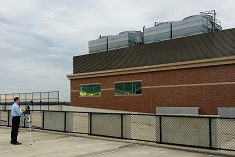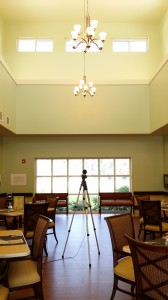Architectural noise control refers to the reduction of sound transmission in buildings using architectural assemblies, such as sound isolating walls, floor/ceiling assemblies, doors, windows, exterior walls, roofs, etc., or the reduction of noise levels within spaces using sound absorbing acoustical treatment. Examples of typical architectural noise control projects include: There are times when a combination of mechanical noise control, vibration isolation, and architectural noise control is required to solve mechanical equipment noise issues in buildings. Other times, such as with the footfall noise example, solutions are strictly architectural in nature and require a detailed evaluation of the existing architectural and structural building elements.
The Process
A three step process is recommended to fully resolve architectural noise issues in buildings.
- The first step is to conduct acoustical field tests to determine the type and magnitude of the noise issue. Standardized tests are used to quantify the extent of a noise problem and compare the results to acceptable criteria for different occupancy types. Please refer to our Acoustical Field Testing/Measurement page for more about the extensive acoustical testing we perform in buildings.
- The next step is to provide project specific acoustical design recommendations, including a comprehensive set of acoustical details and specifications, typically with multiple design options for the Client to consider. Recommendations can be prioritized so the Client can implement them in stages as funds become available.
- Finally, we review the Contractor’s submittals, answer RFIs, and conduct site visits to review the installation of the acoustical assemblies. The importance of this phase should not be underestimated. Most Contractors are unfamiliar with the unique installation requirements of the specialty acoustical assemblies required in many instances. This phase is “where the rubber meets the road” and is often the most critical to the success of the project.
These services can be performed in any building type for any Client. If you have a noise problem in your building, please do not hesitate to call us to discuss how we may be of assistance.


